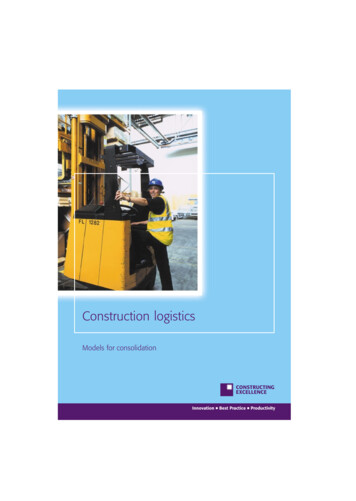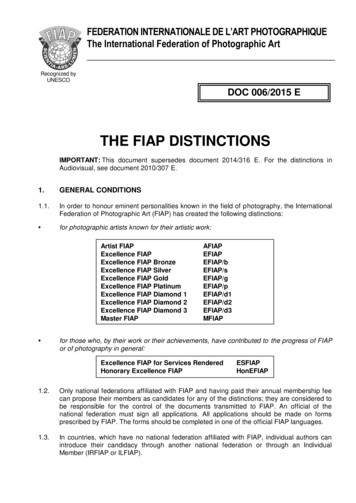
Transcription
Wilson James 20pp7/10/0411:26 amPage 1Construction logisticsModels for consolidationInnovation Best Practice Productivity
Wilson James 20pp7/10/0411:26 amPage 2ContentsForeword3Overview4An industry ripe for changeWhy is change needed?What’s happened in other industries?57Models for changeHow a consolidation centre worksFirst generation – Mid-City PlaceSecond generation – Heathrow Terminals 1-4Third Generation – Multi-site and multi-clientOther ways to consolidate810121616How a consolidation centre accelerates change17ResourcesReferencesWebsitesPeople to talk toResearch and development18181819AcknowledgementsThanks to personnel in BAA, Bovis Lend Lease, Mace, The Logistics Business, Wilson James andothers who have generously given their time to participate in the case study.The Consolidation Centre research project mentioned in this case study is sponsored under theDepartment of Trade and Industry Partners in Innovation scheme.Research and text: Adrian Young – www.brolga.co.ukProduction: The Stables Team – www.stables.co.ukPhotographs supplied by: Wilson JamesISBN 1-905033-07-9 Constructing Excellence, October 2004Requests to reproduce any part of this case study should be sent to Constructing Excellence.2Constructing Excellence – Construction logistics
Wilson James 20pp7/10/0411:26 amPage 3ForewordThe Heathrow Consolidation Centre is much more than an award-winning innovation.It is one of the milestones along construction’s path of continuous improvement, anexemplar of the Constructing Excellence strategy to deliver world-class products andservices.The first of our three objectives in Constructing Excellence is to achieve a step change in performance. Aconsolidation centre does this by imposing discipline on how materials are supplied to the workplace. In taking onsite distribution out of the hands of trade contractors it frees them to focus on what they are good at – constructing.That means better products and higher productivity.Secondly, we believe construction needs to refresh its image if it is to gain wider respect as an efficient, safe industrywhich creates prosperity for individuals, communities and the nation. A consolidation centre brings logisticsprofessionals into the construction team, with the expertise to revolutionise supply chains along the same efficientlines as retail distribution. It is an outstanding example of how construction can learn from keen engagement withother sectors.Our third objective is to bring about improved performance and image by engaging with the widest range ofindividuals and organisations and encouraging them to take action. It is evident, from the examples cited in this casestudy, that the Heathrow Consolidation Centre engages trade contractors head on in better logistics and improvedproductivity. So many small and medium-sized contractors – who erect hoardings, perform groundwork and sitemaintenance, lay flooring, and install toilets and partitions – are enjoying the smooth-running logistics at Heathrow.And the local community benefits from less traffic noise and fumes.Construction faces stricter environmental controls and pressure to become a more sustainable industry. It is rare tofind an innovation responding, with measured results, on so many fronts. The bonus is that it invites contractors, theirsuppliers and hauliers to behave in a more integrated way, with rapid benefits.It would be easy to dismiss consolidation as relevant only to ‘special’ sites such as Heathrow Airport, but this casestudy suggests ways to replicate the idea to serve the wider construction industry.Dennis LenardChief ExecutiveConstructing ExcellenceInnovation Best Practice Productivity3
Wilson James 20pp7/10/0411:26 amPage 4OverviewWhy is construction taking a fresh look at logistics? Wilson James profileTougher planning controls on vehicle movements mean many local authorities will nolonger permit ad hoc deliveries to sites.Seven years after setting up in1991, Wilson James Ltd appeared in Road congestion and limited access to sites press construction managers to find athe Sunday Times list of the 100better way to deliver materials to site and take away waste.fastest growing UK companies.Construction managers have noticed how just-in-time deliveries can boostThrough its three divisionsproductivity.(construction, aviation and security)Public opinion is moving the environmental and social problems caused byconstruction up the corporate agenda. ‘front of house’ services. Annualturnover exceeds 40m and theClients are recognising the knock-on benefits which better management of logisticscompany has some 1300 directlybrings to the performance and image of their businesses.employed full-time staff, many withTHIS CASE STUDY traces the evolution of consolidation centres in the UK with reference toWilson James and its partners, and suggests models for future consolidation solutions.AN INDUSTRY RIPE FOR CHANGE describes what an effective logistics system does andwhy construction needs to change its approach. Concepts borrowed from manufacturingand retailing show how consolidating deliveries imposes discipline on suppliers and offersconstruction the productivity benefits of just-in-time supply.military backgrounds.Wilson James’s role in constructionis to eliminate waste in the supplychain by getting the right materialsand services to the site, just in timefor processes to be completedefficiently. This improvesMODELS FOR CHANGE sets out eight guiding principles of logistics and shows howproductivity, exploits economies ofconsolidation addresses all of them. In its first-generation model, Wilson James managedscale, wastes less material, cutsa just-in-time delivery process from a distribution point within Stanhope’s Mid-City Placetraffic congestion and CO2development in London. In its second-generation model, Wilson James and constructionemissions and reduces injuriesmanager Mace designed and operate the Heathrow Consolidation Centre, a dedicatedcaused by manual handling. Itdistribution centre serving BAA’s Terminals 1-4. The third-generation model shows Wilsondoes all this by making best use ofJames’s ambition to take the consolidation centre concept beyond the confines oftechnology, offering incentives toHeathrow into regional centres to serve a variety of projects and customers. Other ways toencourage its staff and learningconsolidate suggest alternative answers to the logistics question.from the best practices in otherHOW A CONSOLIDATION CENTRE ACCELERATES CHANGE shows that consolidationindustries.addresses many of the themes in the Strategic Forum for Construction’s report AcceleratingChange.RESOURCES contains a list of references, websites, people to talk to, and who’s doing R&D.4it provides logistics, security andConstructing Excellence – Construction logistics
Wilson James 20pp7/10/0411:26 amPage 5An industry ripe for changeWhy is change needed?ManufacturerGlenn Hawkins, Head of BSRIA’s Process and Productivity Department, explains what abig problem ill-conceived storage and handling strategies can be. “In our researchWholesaler/Agentprojects we directly observe operatives. We consistently find about 8–9% of theworking day is lost by a typical tradesman waiting for or collecting materials, tools andequipment. Initially we looked at M&E trades only, but recently we’ve noticed the samein other building trades.”SubcontractorSite storageThe Logistics Business (a supply chain consultancy and software developer) summarisesPoint of useeight principles of good logistics practice and highlights where it believes constructionlags behind best practice in manufacturing and retailing:Source: BRE Digest 459Figure 1: Delivery ChannelsUnderstandingCustomer needs and service levels are poorly understood, hence they are neithercustomer needsmonitored nor improved.SupplierThere are too many suppliers managed in adversarial contracts rather than by servicepartnershipslevel agreements. Selection is by price not value. Relationships tend to be secretive.InformationConstruction is not yet investing enough in technologies which enable the sharing oftechnologyinformation between customers and suppliers.Data managementCapture and management of data does not generally extend beyond purchasing.Control materialsThere is little visibility of goods in the supply chain. Standard technologies in otherand informationindustries, such as bar coding, have made little impact. Hence it is difficult to reducematerial waste because it cannot be tracked.Supply andFigure 1 shows how materials go from the manufacturer to the point of use via at leastdelivery channelseight different channels. The way goods are sourced and distributed is largely driven bysupplier price with little consideration of the value to the customer. It is a confusingsystem of distribution which conceals waste, for example double handling, andsupports mark-ups by intermediaries whose value added is questionable.Eliminating wasteMaterial waste is taken for granted and built into the cost plan. The most common– getting leanforms of waste are time related, but these are not well understood. Waste of anydescription is not widely monitored and few targets for improvement are set.Reducing lead timesAgility is about reducing wasted time. Do companies in construction really know what– agilitythey need to do to become more responsive?Innovation Best Practice Productivity5
Wilson James 20pp7/10/0411:26 amPage 6Logistics is often seen just as storage and transport management, yet this is far from the wholepicture. Leading contractors are investing in logistics research and development for five reasons:An effective logisticseliminates waste andsystem:reduces cost by: cuts the number ofreducing the number of transactionssuppliersand exploiting economies of scalereduces vehicleminimising congestion and queuingmovements onto the site minimises the materialssaving losses due to damage, theft orstored on sitesimply being mislaidtracks goods, materials,utilising resources efficiently, withoutequipment and peopleduplicationplans how resources willensuring that all needs are met at thebe used and allocatedright time and place.Organising the site – Use systems that work in factories forLes Beaumontdaily planning and spatial control.Senior ConsultantSub-assemblies – These reduce assembly on site to theThe Logistics Businessbare minimum.Activity-based costing – Understand the process bymapping out the activities, then cost each activity includingWhat can construction learn from otherindustries?In my experience there is no single transferable model, butlook for processes and technologies that others havedeveloped, such as:Is there a cultural issue here?Yes, I think so. A lot of construction people have atendency to get on with it without much planning. Theylike to solve today’s problems rather than think what canJIT – ‘Just in time’ means frequent replenishment inthey plan today to avoid having to solve problems in abatches according to task and location.month’s time. Also, construction people tend to think ofLine-side supply – This eliminates on-site storage.every building as a new project. Perhaps many peopleIT – By this I mean systems for transferring and sharinginformation about orders and schedules.Product identification – Bar coding is the basic system andRFID (radio frequency identification) offers moresophisticated opportunities.Onboard computing – These are notification systems likethose used for public transport arrivals.6its associated overheads.Constructing Excellence – Construction logisticsdon’t realise they’re actually making something. It’s theproduction mentality that needs to be cultivated, withoutlosing focus on the customer. Some constructioncompanies are leading the way but many have not yetunderstood the opportunities.
Wilson James 20pp7/10/0411:26 amPage 7What’s happened in other industries?Comparisons with manufacturing are inevitable because it looks fundamentally thesame as construction – making things by assembling constituent parts. Yet the twoConstruction:Customised productsproduced slowly andat high costManufacturing:Homogenous productsproduced quickly andat low costare working from different bases. Figure 2 illustrates how construction andmanufacturing respond to the lean production challenge. For construction to followmanufacturing’s lead, there may be an intermediate phase of learning to producehomogeneous products quickly and at low cost before it can aspire to the ultimate:customised products produced quickly and at low cost. So learning howThe goal:Customised products produced quicklyand at low costmanufacturing produces homogeneous products cheaply and quickly meritsinvestigation.Source: Horman and Kenley (text modified)Figure 2: Lean production challengeFrom a logistics point of view, the most significant learning point is delivery ofmaterials just in time for assembly, see Figure 3. Leading manufacturers haveachieved it by: developing long-term relationships with a small number of trusted suppliers withwhom they share design and production information and make continuousComponent and sub-assemblysuppliersimprovements eliminating the storage of materials in the factory in favour of line-side delivery.ManufacturerJITRetailing offers another clue. Retail chains differ from manufacturing companies inthat each has a large number of sites (retail stores) compared to the small number offactories that each manufacturer has. Retailing has invented the regional distributioncentre, see Figure 4, to avoid a large number of deliveries from each supplier whilestill enjoying a JIT service.CustomersFigure 3: ManufacturingThe models in Figures 3 and 4, combined, are the basis for the HeathrowConsolidation Centre.ManufacturersJITRegional distribution centreJITShopsFigure 4: RetailingInnovation Best Practice Productivity7
Wilson James 20pp7/10/0411:26 amPage 8Models for changeHow a consolidation centre worksA consolidation centre is like a retail regional distribution centre and is so named becauseit ‘consolidates’ many different loads onto one site-delivery vehicle. With the exception ofsome equipment and materials that are more conveniently delivered direct to sites, it isthe one-stop point of delivery for virtually all supplies. It does not hold stock for anyappreciable length of time but it is a useful distribution buffer. It is responsible for allitems in its care.There are six steps in dealing with materials (see Figure 5):1.The trade contractor places orders for supplies, specifying delivery to theconsolidation centre.2.The consolidation centre agrees an inward delivery time and takes delivery.Component andsub-assembly ist sub-contractorsWholesalers/AgentsJITConsolidation CentreJITOrdersCall deliveryTrade contractorsEverything is checked and labelled to simplify distribution.3.About 24 hours before supplies are needed, the trade contractor requests delivery,stating exactly what, where and when.4.The consolidation centre makes up ‘daypacks’ for each task.5.The consolidation centre delivers the daypacks just in time for each gang toundertake that day’s tasks.6.The consolidation centre removes excess materials from the site every day.This simple process alone has five immediate benefits: Proper management of distribution reduces the number of vehicles and consequentcongestion and pollution. Skilled operatives can get on with what they are being paid to do without thedisruption of unloading supplies. Over-ordering is reduced because the system enforces planning. Trained personnel (using appropriate equipment) place materials where they areneeded, thus reducing manual handling risks and damage to material. The site is tidier, leading to better productivity and fewer accidents.Once established, this process opens up many possibilities. Using the consolidationcentre makes the whole distribution process simpler and more transparent. Logisticsspecialists at the consolidation centre can work with trade contractors to help themunderstand and improve their distribution. The consolidation centre can also help tradecontractors to collaborate in purchasing.If dedicated to one project a consolidation centre is likely to be at or near the site. But itcan work equally well some distance from the site. One centre can also serve many sites.8Constructing Excellence – Construction logisticsFigure 5: Orders and deliveries viaa consolidation centre
Wilson James 20pp7/10/0411:26 amPage 9How this addresses the eight principles of logisticsUnderstanding customer needsContractors learn to understand their ownManufacturerneeds in logistical terms.Supplier partnershipsCollaboration is essential.Information technologyInvestment can now be justified.Data managementThe consolidation centre arranges this.Control materials and informationLogistics IT systems are the tools for tradeWholesaler/AgentSubcontractorConsolidation Centrecontractors to use.Supply and delivery channels.There are only two channels to the point of(Compare Figures 1 and 6)use, instead of four.Eliminating wasteLess material is consumed. Productivity rises.Point of useFigure 6: Delivery channels –simplified via a consolidation centre– getting leanReducing lead timesThe consolidation centre is a JIT concept,– agilitygeared to quick response.Innovation Best Practice Productivity9
Wilson James 20pp7/10/0411:26 amPage 10First generation – Mid-City PlaceDistribution within the construction site onlyStanhope, the developer of Mid-City Place, quickly recognised that distribution ofmaterials on the site would be a critical issue for the construction manager, BovisLend Lease, and encouraged a fresh approach to logistics. Wilson James developeda strategy to reduce multi-handling and repeated moving of materials.The twin-track solution: distributed materials to the workplace just in time for each task created the Market Place, a single on-site distribution point for bulkmaterials and consumables.Although Wilson James’s brief was confined to the site, it influenced, but did notcontrol, deliveries to the gate. However from that point onwards, it took thedistribution out of the hands of trade contractors.The headline results were stunning: Mid-City Place was completed in 57 weeks, 11 weeks ahead of theMid-City Place is a 53m, 470,000 ft2 officeplanned programme. The build rate was about 8,000ft2 per week, 60% ahead of the industrybenchmark at that time. the West End and the City of London,completed in 2001.The building cost was 92/ft , against the Davis Langdon Everest database2benchmark of 115/ft2. development in Holborn, midway betweenFigure 7: Mid-City PlaceThere were 675,000 hours worked without a single reportable accident. Thiscompares favourably with BAA’s One in a million challenge to get reportable accidentrates down from the industry average of about 1.3 per 100,000 hours to one in amillion hours worked.Improved logistics achieved: some 35% less material waste than benchmark sites dry lining waste reduction from 10% to 3% distribution with one less pair of hoists than originally expectedCredits almost 100% performance in materials being distributed in the right time and placeClient – Stanhope significant savings in contractors’ time related to handling materials.Construction manager – Bovis Lend LeaseWilson James also had a facilities management role at Mid-City Place, taking responsibilityfor security, hoardings, inductions, welfare and aspects of health and safety.10 Constructing Excellence – Construction logisticsLogistics manager – Wilson JamesBuild planning system – A3D
Wilson James 20pp7/10/0411:26 amPage 11How the Market Place supplied consumablesPaul SimsDivisional DirectorBovis Lend LeaseStart ofthe day100% materialavailable on trolleyTeam starts workand consumesmaterialHow did this all start?Kanban OrderThe penny really dropped when we visitedABCthe Jaguar production line with CoughlinLogistics and Wilson James and saw how line-Approx.1600 hrsside supply boosts productivity. InTrade contractor supervisor records materialused and re-orders from Market PlaceMarketPlaceconstruction, skilled labour down tools tounload deliveries. I asked Coughlin to studythe potential benefits of line-side supply atMid-City Place. We could immediately seeimprovements in productivity and a reductionin both waste production and resourcesrequired. It was simple really, so we took theApprox.1700 hrsplunge.MarketPlaceMaterial delivered from Market Place totrolley at point of use to replace stockHaven’t we been here before?Absolutely. 20 years ago the main contractorhad a gang to handle deliveries and keep theBuild planningAt Mid-City Place, Bovis Lend Lease and its trade contractors used 4Dmodelling to produce daily build plans (4D means three dimensions plustime). The 4D model predicts what will happen each day and the buildsite clean. But management contractors nolonger have operatives so this role waspassed to the trade contractors.What about the economics?planning tool sets out the tasks to be completed and schedules all theIt’s difficult to be explicit because so many ofcomponents. Wilson James interpreted what each activity was pulling day bythe benefits are hard to measure. But we’reday to create a dynamic schedule of packaging and palletising activities withsure that Wilson James helped achieve a bigloading and delivery timings. This ensured JIT delivery and optimal utilisationimprovement. Be aware however, there areof the movement team.many vested interests in logistics remainingThe combined 4D modelling and build planning tool used at Mid-City Place isdemonstrated at www.architectural3D.co.uk.disorganised. Every 1% of material you stopgoing in the skip is a 1% drop in sales.What would you like to see next?There is actually a science to this. It takes alot of planning to control materials flowingonto the site. By ‘pulling in’ the materials youneed to complete specific tasks you completethe work faster and minimise waste. I’d likepeople to think about that one!Innovation Best Practice Productivity 11
Wilson James 20pp7/10/0411:26 amPage 12Second generation – Heathrow Terminals 1-4Delivery from a dedicated consolidation centreChris CtoriAlthough it is Terminal 5 making the news, BAA spends a whopping 250mFacilities Strategyannually on its existing Heathrow terminals. The Heathrow Consolidation CentreManager and Chair ofserves Terminals 1-4 and won the BAA Sustainability Award 2001, also sponsoredthe Consolidationby CIRIA and Forum for the Future. It is located in a 20,000 ft2 hangar at HattonCentre BoardCross near the easternBAAend of the airport. Inaddition, a controlledoutdoor area holdsWhat’s BAA’s objective here?weather-resistantWe’re constructing for a one third increase insupplies. The annualpassenger numbers by 2014. We have tworunning cost is aboutdrivers: the need to reduce the local impact 2m.of construction and the need to improveConstruction managerproductivity, reliability and value for money.Mace and WilsonDo you use consolidation processesJames jointly designedelsewhere at Heathrow?the Consolidation Centre. Mace has three people dealing with Centremanagement, strategic development and integration with construction projectswhile Wilson James has a workforce of 30 in day and night operations. BAA isconvinced of the business case and has a similar facility to serve T5.“The Consolidation Centre looks like a warehouse, but it works differently,” saysYes, we use retail logistics to deliver goodsairside at all our terminals for much the samereasons as we now do it for construction – itneeds fewer vehicles, it’s more secure and itcosts less.Gary Sullivan, Director of Wilson James. “The Centre holds only the materials andequipment actually needed on the site; but only for a few days and there is noIs everyone using the Consolidationtriggering fresh orders when stock levels fall. The critical thing is that the Centre isCentre?in the loop when contractors place orders. It takes care of deliveries via one gate,Not quite, we still have some people workingrecords and labels everything, checks quantity and condition, assembles whataround the rules and inducements are on thecontractors need for each task the day before, then distributes it to agreed drop-offway to ensure compliance.points while the airport is closed to aircraft overnight.” Figure 8 illustrates theconsolidation process.What of the future?The Centre handles some pre-assembled modules, but does not handle thoseTransferring what we’ve learned to T5 ismodules installed directly from lorries, ready-mixed concrete and steel frames.critical and we need to develop our ITThere are contingency procedures for daytime and emergency deliveries. Insystems. But remember the 10-yearalmost three years of operation, the Consolidation Centre has served some 40construction budget in Terminals 1 to 4 ismajor projects at Heathrow. There are typically 60 trade contractors on the airport 3bn, so our Consolidation Centre has a lotevery day, employing some 2000 people.of work to do in helping everyone to improvelogistics.12 Constructing Excellence – Construction logistics
Wilson James 20pp7/10/0411:26 amPage 13ContractorsSuppliersPlasterboardT1 liftsSwitchgearT2 fit outLift carsT2 roofDoor setsT3 fit SwitchgearT2 fit outLift carsT2 roofDoor setsConsolidationCentreInsulationInsulationT3 roofTilesT4 liftsCablesT4 electricalCladdingCladdingT3 fit outT3 roofTilesCablesT1 liftsT4 liftsRemove excessmaterials andreusable packagingBEFORET4 electricalAFTERFigure 8: How consolidation simplifies distribution at Heathrow Terminals 1-4What BAA’s trade contractors say“When we lay sheet vinyls and linoleum at Heathrow, having the materials delivereddirectly to where we’re working is a big benefit to us. Productivity is noticeably better thanat other sites because our workforce is not unloading and handling material.”Mike Savage, Sales Director, Ideal Interiors (Southern) Ltd.“Productivity goes up when we fit out toilets and do joinery work at Heathrow. It’s havingone large delivery to the Consolidation Centre that is broken down into smaller just-in-timedeliveries to site that makes the difference.”Chrissie Lynch, Director, Intelligent Modular Solutions Ltd.“Erecting hoardings, groundwork and site maintenance is what we do at Heathrow. Gettingour materials through the Consolidation Centre is certainly more reliable, but it does makeus plan ahead because same day deliveries cannot always be arranged.”Michael McCafferty, Director, MMC Building Contractors Ltd.Performance targetsThe economic and environmental impact depends on delivering the right goods to tradecontractors in the right quantities and right condition, in the right place and at the righttime. A ‘dashboard’ of Key Performance Indicators keeps attention focused on this primaryobjective.JIT deliveries to the work place – The target for the timely delivery of daypacks was 95%.Credits“This would not be a credible target in retailing and we exceeded it in just a few months,”says Sullivan. Audits show that 99% of daypacks are complete and delivered to the rightplace on time.Client – BAAManager – MaceOperations – Wilson JamesInnovation Best Practice Productivity 13
Wilson James 20pp7/10/0411:26 amPage 14Task completion – A sample of six projects, three completed before and threecompleted after the Consolidation Centre was commissioned, showed the rate ofJohn Brookstask completion up from 66% to 76%. Almost half of the improvement was dueto availability of materials (see Build planning).Project ManagerCost of distribution – A survey of 20 trade contractors carrying out packagesMacevalued at 19m reported a saving of 650k in the cost of distribution of materialsalone, attributed to the Consolidation Centre. After allowing for the cost of theservice, the saving is typically 2% of total construction value, about double what itcosts to run the Centre.How do you reduce vehicle congestionand emissions?The local environment – The headline measurable environmental gain is that theIn the first instance, we have reduced thedistance travelled by local delivery vehicles fell by 20,000 miles annually. This is anumber of local delivery journeys by 40% by40% reduction. Under the new regime, the Consolidation Centre specifies deliverydirecting deliveries away from the busytimes to reduce congestion and it promotes the re-use of pallets and packaging.terminals and through consolidating loads atThe Consolidation Centre also contributes to improved airport security, localthe Centre. Secondly, we control the deliveryemployment and fewer accidents on the road and on site.routes of deliveries from the Centre to theBuild planningsites to avoid congested areas at differenttimes of the day and night.BAA prefers to use Last Planner, a favourite with production-savvy contractors (seewww.leanconstruction.org/learning.htm). Last Planner helps supervisors assessHow do you justify claims of improvedwhere and why they are not reaching production targets. They use Last Planner toproductivity?plan activities with a five-week ‘look ahead’. As well as planning the activities, italso identifies the ‘make ready’ needs, which include the material, plant andhuman resources. Part of the Consolidation Centre’s liaison role with tradecontractors is to gain forward visibility of material and plant demands via schedulescreated with Last Planner.By analysing project results from Last Plannerwe know that plan reliability on our projectshas improved by 4% because of theConsolidation Centre, which leads on tobetter productivity. In addition, the tradeOne of the common reasons for missed targets is not having the right materials incontractors can now concentrate on their corethe right place at the right time. Hence, the Consolidation Centre’s delivery recordproduction tasks, rather than having to dealleads to a radical improvem
manager Mace designed and operate the Heathrow Consolidation Centre, a dedicated distribution centre serving BAA's Terminals 1-4. The third-generationmodel shows Wilson James's ambition to take the consolidation centre concept beyond the confines of Heathrow into regional centres to serve a variety of projects and customers. Otherways to










